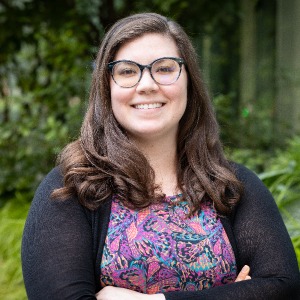
August 2023 Newsletter

August 2023 Newsletter

Student Profile
Emily Stroup is a fifth-year PhD candidate in the Driskill Graduate Program. Prior to coming to Northwestern, she graduated from the University of Notre Dame, where she studied physics in medicine.
In the lab of Zhe Ji, PhD, assistant professor of Pharmacology and McCormick School of Engineering, Stroup combines her data and computational skills with medicine to develop deep learning models to better understand polyadenylation.
Where is your hometown?
I was born in Overland Park, Kansas, near Kansas City, but I consider Fort Wayne, Indiana, my hometown. My family moved there when I was ten years old, and it’s where most of the memories and experiences that shaped who I am happened.
What sparked your interest in science or medicine?
As far back as I can remember, I have been extremely curious about the world around me and constantly asked questions about new things I encountered. I wanted to learn as much as possible and was naturally drawn to math and science. My high school physics teacher and math teacher were incredible and sparked my interest in how we could mathematically explain the world and connect what I thought were disparate fields of study. This motivated me to pursue physics in medicine in college, where I worked with a research mentor who used traditional physics research techniques to study cancer cell growth. This experience opened my eyes to the opportunities for interdisciplinary research in science and medicine.
What are your research interests?
My interests are interdisciplinary, bridging biology and human health with math and computational analysis. In particular, I am very passionate about repurposing existing yet underutilized datasets. There is so much data generated or collected but not fully explored, especially with the increased accessibility of sequencing over the past decade. I’ve worked on several projects that utilize published data or large consortium databases to answer new biological questions, and I believe this avenue of research helps maximize the efforts and benefits of biomedical research.
What are you currently working on?
My recent work has been focused on developing deep learning models of polyadenylation regulation in humans and other species. As mRNA are transcribed, there are many potential sites along the gene where the transcript can be cleaved and a polyA tail synthesized as part of the mRNA maturation process. However, the factors that govern site selection are not well understood. I have leveraged previously published sequencing data from dozens of samples to model where polyadenylation sites are found in the genome and to explain the factors that promote site utilization. We hope this work will further our understanding of how polyadenylation activity has been optimized on an evolutionary timescale and provide a resource to characterize disease-associated variants that alter polyadenylation dynamics.
Please tell us about a defining moment in your education at Feinberg thus far.
During my second and third years, I participated in the Biomedical Data Driven Discovery training grant, which helped set the course of both my project and my development as a scientist. Through this program, I took math, statistics and data analytics classes on the Evanston campus, which provided a solid technical foundation for my research. I also regularly interacted with students and faculty across different domains, who brought new perspectives from their respective fields that broadened the way I think about approaching research challenges.
What do you hope to do with your degree?
I want to continue developing new computational techniques to gain insights from biomedical and healthcare data to advance our knowledge of human disease and how we deliver care. My work in the lab has predominantly been focused on dissecting a fundamental process in RNA biology and how it is dysregulated during disease formation. I hope to use the skills I’ve accumulated at Feinberg to translate information uncovered from the vast amount of data available to improve human health and how we provide care to our community.